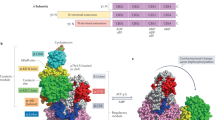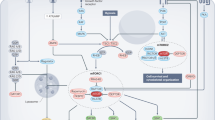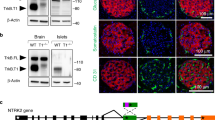Abstract
AMP-activated protein kinase (AMPK) is the downstream component of a protein kinase cascade that plays a major role in maintaining energy homoeostasis. Within individual cells, AMPK is activated by a rise in the AMP/ATP ratio that occurs following a fall in ATP levels. AMPK is also regulated by the adipokines, adiponectin and leptin, hormones that are secreted from adipocytes. AMPK regulates a wide range of metabolic pathways, including fatty acid oxidation, fatty acid synthesis, glycolysis and gluconeogenesis. In peripheral tissues, activation of AMPK leads to responses that are beneficial in counteracting the deleterious effects that arise in the metabolic syndrome. Recent studies have demonstrated that modulation of AMPK activity in the hypothalamus plays a role in feeding. A decrease in hypothalamic AMPK activity is associated with decreased feeding, whereas activation of AMPK leads to increased food intake. Furthermore, signalling pathways occurring in the hypothalamus lead to changes in AMPK activity in peripheral tissues, such as skeletal muscle, via the sympathetic nervous system. AMPK, therefore, provides a mechanism for monitoring changes in energy metabolism within individual cells and at the level of the whole body. Activation of AMPK requires phosphorylation of threonine 172 (Thr-172) within the catalytic subunit. Recent studies have shown that both LKB1 and Ca2+/calmodulin-dependent protein kinase kinase-β (CaMKKβ) play important roles in phosphorylating and activating AMPK. In addition, there is evidence that AMPK can be activated by other upstream kinases, although the physiological significance of this is not clear at present. This review focuses on the role of LKB1 and CaMKKβ in the regulation of AMPK.
This is a preview of subscription content, access via your institution
Access options
Subscribe to this journal
Receive 12 print issues and online access
$259.00 per year
only $21.58 per issue
Buy this article
- Purchase on Springer Link
- Instant access to full article PDF
Prices may be subject to local taxes which are calculated during checkout


Similar content being viewed by others
References
Carling D . The AMP-activated protein kinase cascade—a unifying system for energy control. Trends Biochem Sci 2004; 29: 18–24.
Hardie DG, Carling D, Carlson M . The AMP-activated/SNF1 protein kinase subfamily: metabolic sensors of the eukaryotic cell? Annu Rev Biochem 1998; 67: 821–855.
Hardie DG, Salt IP, Hawley SA, Davies SP . AMP-activated protein kinase: an ultrasensitive system for monitoring cellular energy charge. Biochem J 1999; 338: 717–722.
Cheung PCF, Salt IP, Davies SP, Hardie DG, Carling D . Characterization of AMP-activated protein kinase gamma-subunit isoforms and their role in AMP binding. Biochem J 2000; 346: 659–669.
Bateman A . The structure of a domain common to archaebacteria and the homocystinuria disease protein. Trends Biochem Sci 1997; 22: 12–13.
Blair E, Redwood C, Ashrafian H, Ostman-Smith I, Watkins H . Mutations in the gamma(2) subunit of AMP-activated protein kinase cause familial hypertrophic cardiomyopathy: evidence for the central role of energy compromise in disease pathogenesis. Hum Mol Genet 2001; 10: 1215–1220.
Gollob MH, Green MS, Tang ASL, Gollob T, Karibe A, Ali Hassan AS et al. Identification of a gene responsible for familial Wolff-Parkinson-White syndrome. N Engl J Med 2001; 344: 1823–1831.
Arad M, Benson DW, Perez-Atayde AR, McKenna WJ, Sparks EA, Kanter RJ et al. Constitutively active AMP kinase mutations cause glycogen storage disease mimicking hypertrophic cardiomyopathy. J Clin Invest 2002; 109: 357–362.
Daniel T, Carling D . Functional analysis of mutations in the γ2 subunit of AMP-activated protein kinase associated with cardiac hypertrophy and Wolff-Parkinson-White syndrome. J Biol Chem 2002; 277: 51017–51024.
Scott JW, Hawley SA, Green KA, Anis M, Stewart G, Scullion GA et al. CBS domains form energy-sensing modules whose binding of adenosine ligands is disrupted by disease mutations. J Clin Invest 2004; 113: 274–284.
Woods A, Munday MR, Scott J, Yang X, Carlson M, Carling D . Yeast SNF1 is functionally related to mammalian AMP-activated protein kinase and regulates acetyl-CoA carboxylase in vivo. J Biol Chem 1994; 269: 19509–19515.
Sanders MJ, Grondin PO, Hegarty BD, Snowden MA, Carling D . Investigating the mechanism for AMP activation of the AMP-activated protein kinase cascade. Biochem J 2007; 403: 139–148.
Carling D, Zammit VA, Hardie DG . A common bicyclic protein kinase cascade inactivates the regulatory enzymes of fatty acid and cholesterol biosynthesis. FEBS Lett 1987; 223: 217–222.
Suter M, Riek U, Tuerk R, Schlattner U, Wallimann T, Neumann D . Dissecting the role of 5′-AMP for allosteric stimulation. activation, and deactivation of AMP-activated protein kinase. J Biol Chem 2006; 281: 32207–32216.
Hawley SA, Davison MD, Woods A, Davies SP, Beri RK, Carling D et al. Characterization of the AMP-activated protein kinase kinase from rat liver and identification of threonine 172 as the major site at which it phosphorylates AMP-activated protein kinase. J Biol Chem 1996; 271: 27879–27887.
Hong SP, Leiper FC, Woods A, Carling D, Carlson M . Activation of yeast Snf1 and mammalian AMP-activated protein kinase by upstream kinases. Proc Natl Acad Sci USA 2003; 100: 8839–8843.
Sutherland CM, Hawley SA, McCartney RR, Leech A, Stark MJ, Schmidt MC et al. Elm1p is one of three upstream kinases for the Saccharomyces cerevisiae SNF1 complex. Curr Biol 2003; 13: 1299–1305.
Hemminki A, Markie D, Tomlinson I, Avizienyte E, Roth S, Loukola A et al. A serine/threonine kinase gene defective in Peutz-Jeghers syndrome. Nature 1998; 391: 184–187.
Jenne DE, Reimann H, Nezu JI, Friedel W, Loff S, Jeschke R et al. Peutz-Jeghers syndrome is caused by mutations in a novel serine threonine kinase. Nature Genet 1998; 18: 38–43.
Hawley SA, Selbert MA, Goldstein EG, Edelman AM, Carling D, Hardie DG . 5′-AMP activates the AMP-activated protein kinase cascade, and Ca2+/calmodulin activates the calmodulin-dependent protein kinase I cascade, via three independent mechanisms. J Biol Chem 1995; 270: 27186–27191.
Hawley SA, Boudeau J, Reid JL, Mustard KJ, Udd L, Mäkelä TP et al. Complexes between the LKB1 tumor suppressor, STRAD alpha/beta and MO25 alpha/beta are upstream kinases in the AMP-activated protein kinase cascade. J Biol 2003; 2: 28.
Woods A, Johnstone SR, Dickerson K, Leiper FC, Fryer LG, Neumann D et al. LKB1 is the upstream kinase in the AMP-activated protein kinase cascade. Curr Biol 2003; 13: 2004–2008.
Davies SP, Helps NR, Cohen PTW, Hardie DG . 5′-AMP inhibits dephosphorylation, as well as promoting phosphorylation, of the AMP-activated protein kinase—Studies using bacterially expressed human protein phosphatase-2C alpha and native bovine protein phosphatase-2AC. FEBS Lett 1995; 377: 421–425.
Sakamoto K, Goransson O, Hardie DG, Alessi DR . Activity of LKB1 and AMPK-related kinases in skeletal muscle: effects of contraction, phenformin, and AICAR. Am J Physiol 2004; 287: E310–E317.
Sakamoto K, McCarthy A, Smith D, Green KA, Hardie GD, Ashworth A et al. Deficiency of LKB1 in skeletal muscle prevents AMPK activation and glucose uptake during contraction. EMBO J 2005; 24: 1810–1820.
Sakamoto K, Zarrinpashneh E, Budas GR, Pouleur AC, Dutta A, Prescott AR et al. Deficiency of LKB1 in heart prevents ischemia-mediated activation of AMPKalpha2 but not AMPKalpha1. Am J Physiol 2006; 290: E780–E788.
Shaw RJ, Lamia KA, Vasquez D, Koo SH, Bardeesy N, Depinho RA et al. The kinase LKB1 mediates glucose homeostasis in liver and therapeutic effects of metformin. Science 2005; 310: 1642–1646.
Woods A, Dickerson K, Heath R, Hong SP, Momcilovic M, Johnstone SR et al. Ca2+/calmodulin-dependent protein kinase kinase-beta acts upstream of AMP-activated protein kinase in mammalian cells. Cell Metab 2005; 2: 21–33.
Hawley SA, Pan DA, Mustard KJ, Ross L, Bain J, Edelman AM et al. Calmodulin-dependent protein kinase kinase-beta is an alternative upstream kinase for AMP-activated protein kinase. Cell Metab 2005; 2: 9–19.
Stahmann N, Woods A, Carling D, Heller R . Thrombin activates AMP-activated protein kinase in endothelial cells via a pathway involving Ca2+/calmodulin-dependent protein kinase kinase beta. Mol Cell Biol 2006; 26: 5933–5945.
Tamas P, Hawley SA, Clarke RG, Mustard KJ, Green K, Hardie DG et al. Regulation of the energy sensor AMP-activated protein kinase by antigen receptor and Ca2+ in T lymphocytes. J Exp Med 2006; 203: 1665–1670.
Momcilovic M, Hong SP, Carlson M . Mammalian TAK1 activates Snf1 protein kinase in yeast and phosphorylates AMP-activated protein kinase in vitro. J Biol Chem 2006; 281: 25336–25343.
Acknowledgements
Studies in the authors' laboratory were funded by the Medical Research Council (UK) and the European Commission (LSHM-CT-2004-005272 and LSHG-CT-2005-518181). MJS is the recipient of a BBSRC-CASE studentship award.
Author information
Authors and Affiliations
Corresponding author
Additional information
Conflict of interest
The authors state no conflict of interest.
Rights and permissions
About this article
Cite this article
Carling, D., Sanders, M. & Woods, A. The regulation of AMP-activated protein kinase by upstream kinases. Int J Obes 32 (Suppl 4), S55–S59 (2008). https://doi.org/10.1038/ijo.2008.124
Published:
Issue Date:
DOI: https://doi.org/10.1038/ijo.2008.124
Keywords
This article is cited by
-
Vincamine as an agonist of G-protein-coupled receptor 40 effectively ameliorates diabetic peripheral neuropathy in mice
Acta Pharmacologica Sinica (2023)
-
Mitochondrial ATP synthase as a direct molecular target of chromium(III) to ameliorate hyperglycaemia stress
Nature Communications (2023)
-
The safety and effectiveness of high-calorie therapy for treating amyotrophic lateral sclerosis: a systematic review and meta-analysis
Journal of Neurology (2023)
-
Metabolic and Genetic Association of Vitamin D with Calcium Signaling and Insulin Resistance
Indian Journal of Clinical Biochemistry (2023)
-
PRKAA1 predicts prognosis and is associated with immune characteristics in gastric cancer
Functional & Integrative Genomics (2023)



